Role of catalpol in ameliorating the pathogenesis of experimental autoimmune encephalomyelitis by increasing the level of noradrenaline in the locus coeruleus
- Authors:
- Qian Li
- Tao Yang
- An‑Chen Guo
- Yong‑Ping Fan
-
Affiliations: Department of Chinese Medicine, Beijing Tiantan Hospital, Capital Medical University, Beijing 100050, P.R. China, Laboratory of Clinical Medical Research, Beijing Tiantan Hospital, Capital Medical University, Beijing 100050, P.R. China - Published online on: January 5, 2018 https://doi.org/10.3892/mmr.2018.8378
- Pages: 4163-4172
-
Copyright: © Li et al. This is an open access article distributed under the terms of Creative Commons Attribution License.
This article is mentioned in:
Abstract
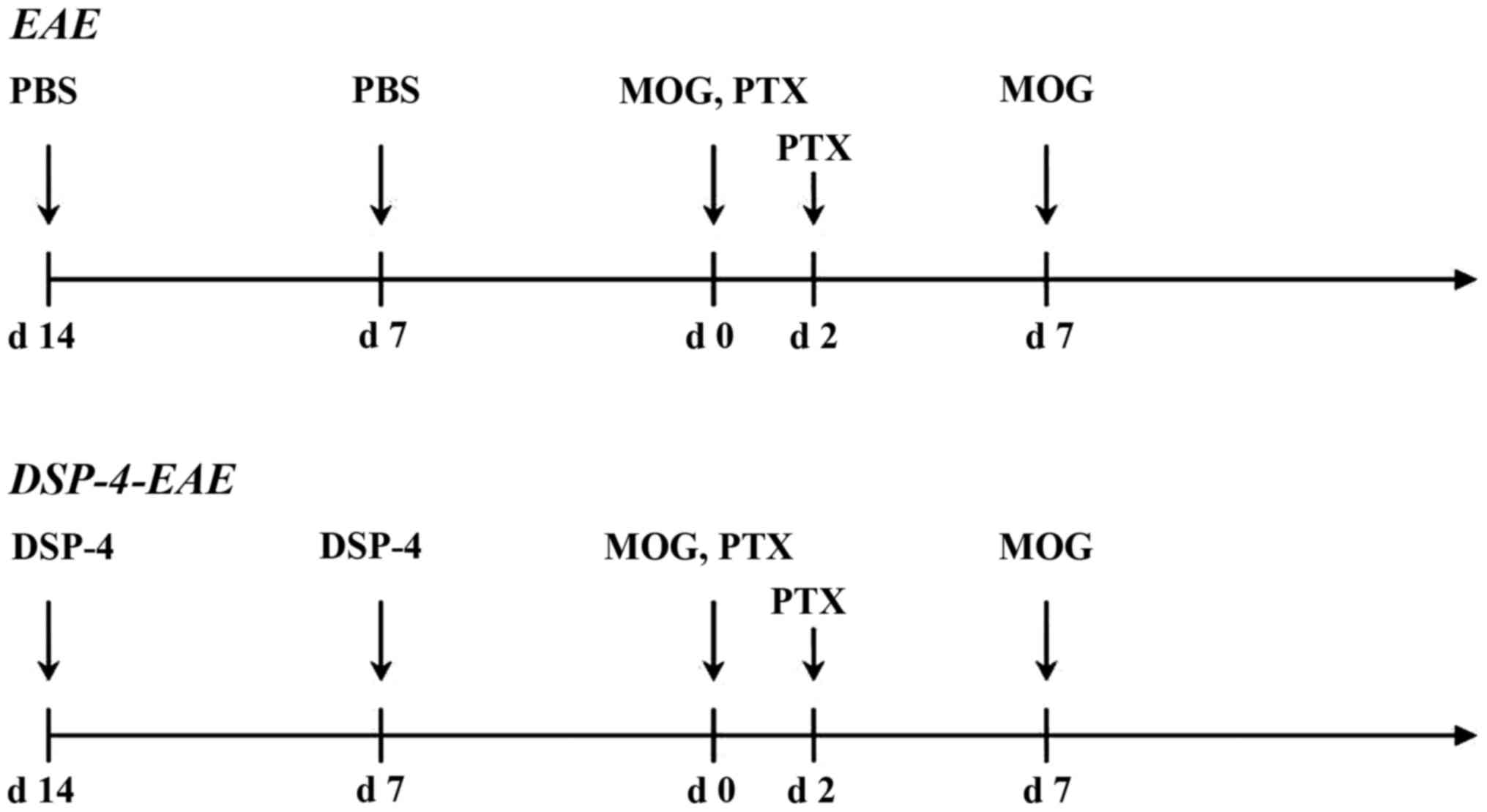 |
 |
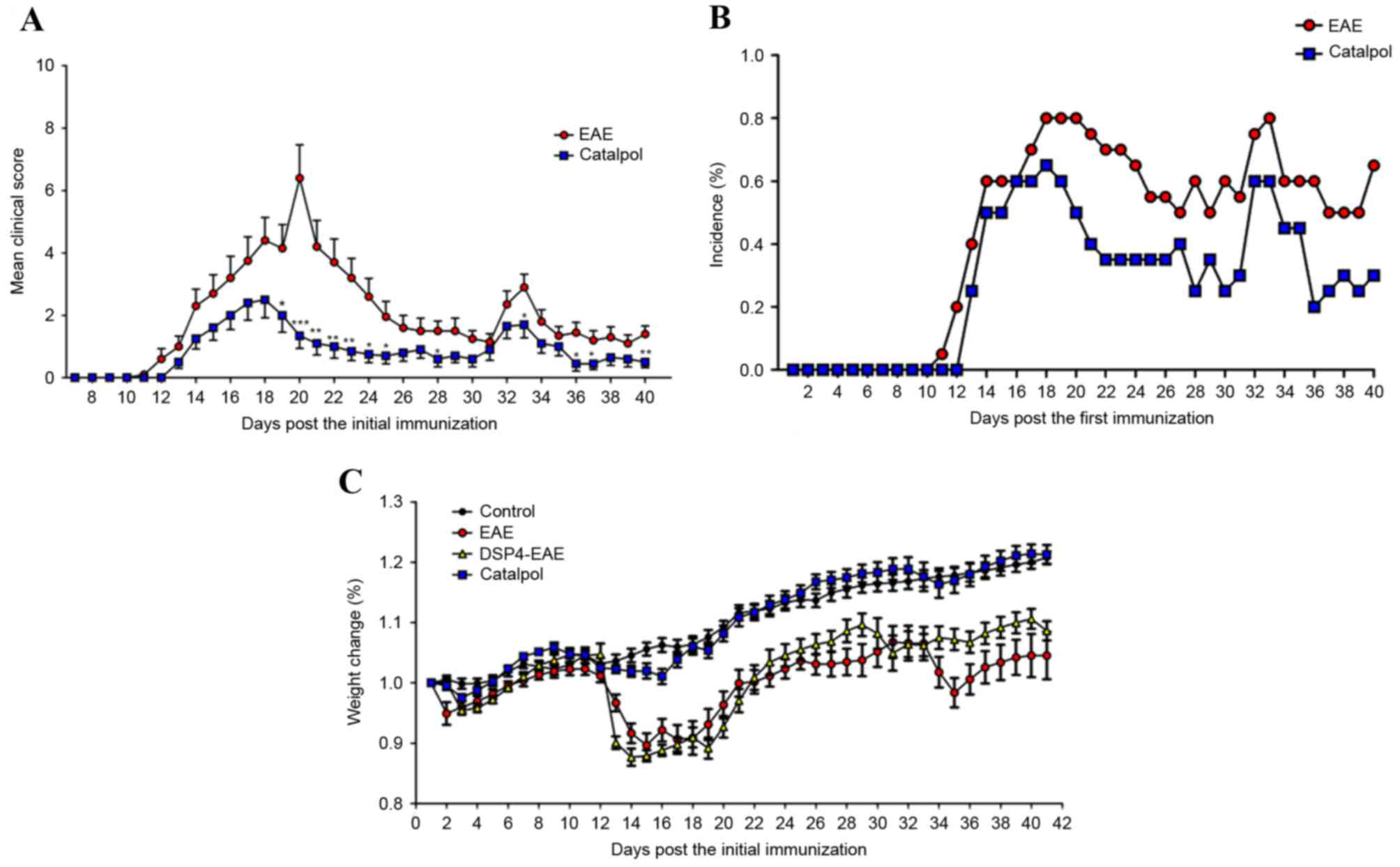 |
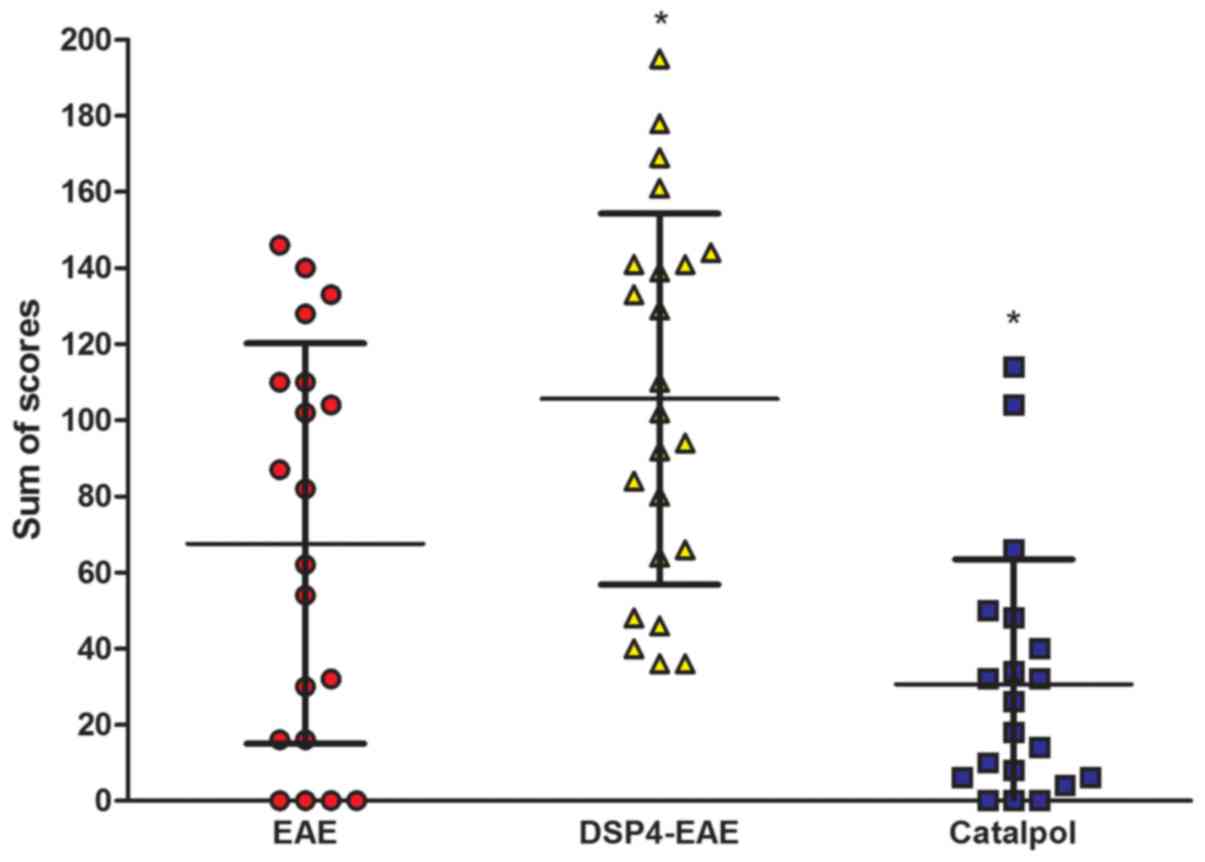 |
 |
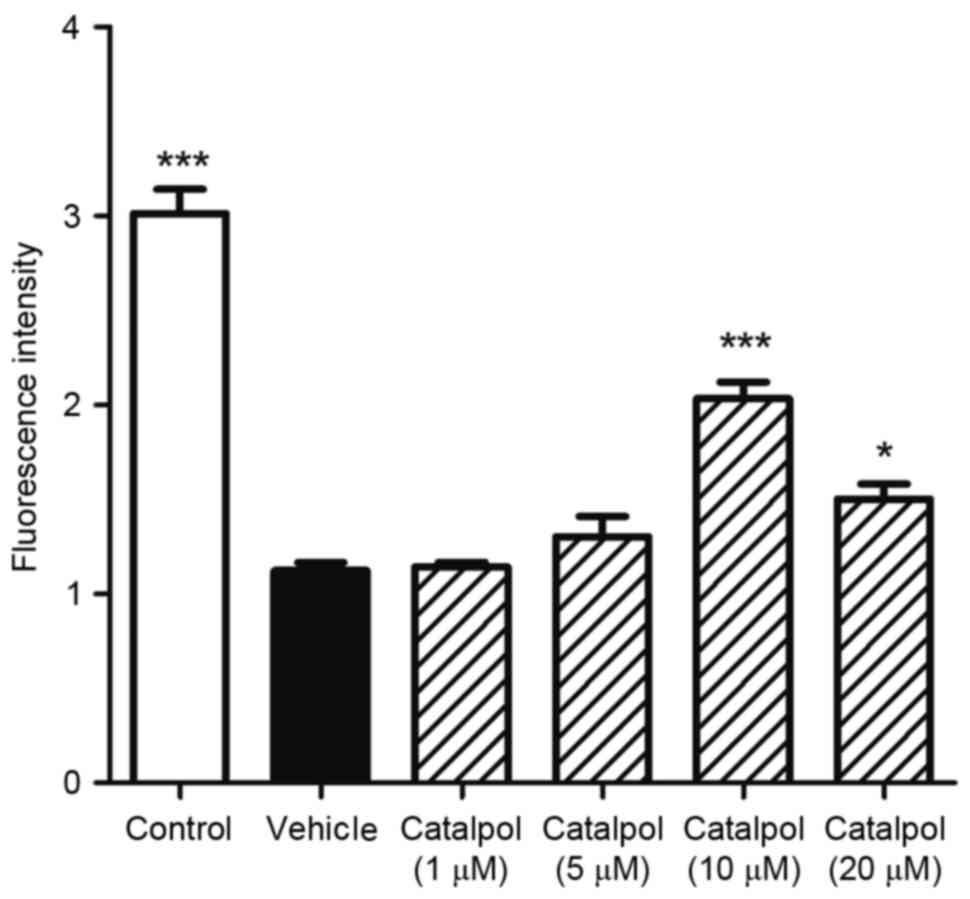 |
 |
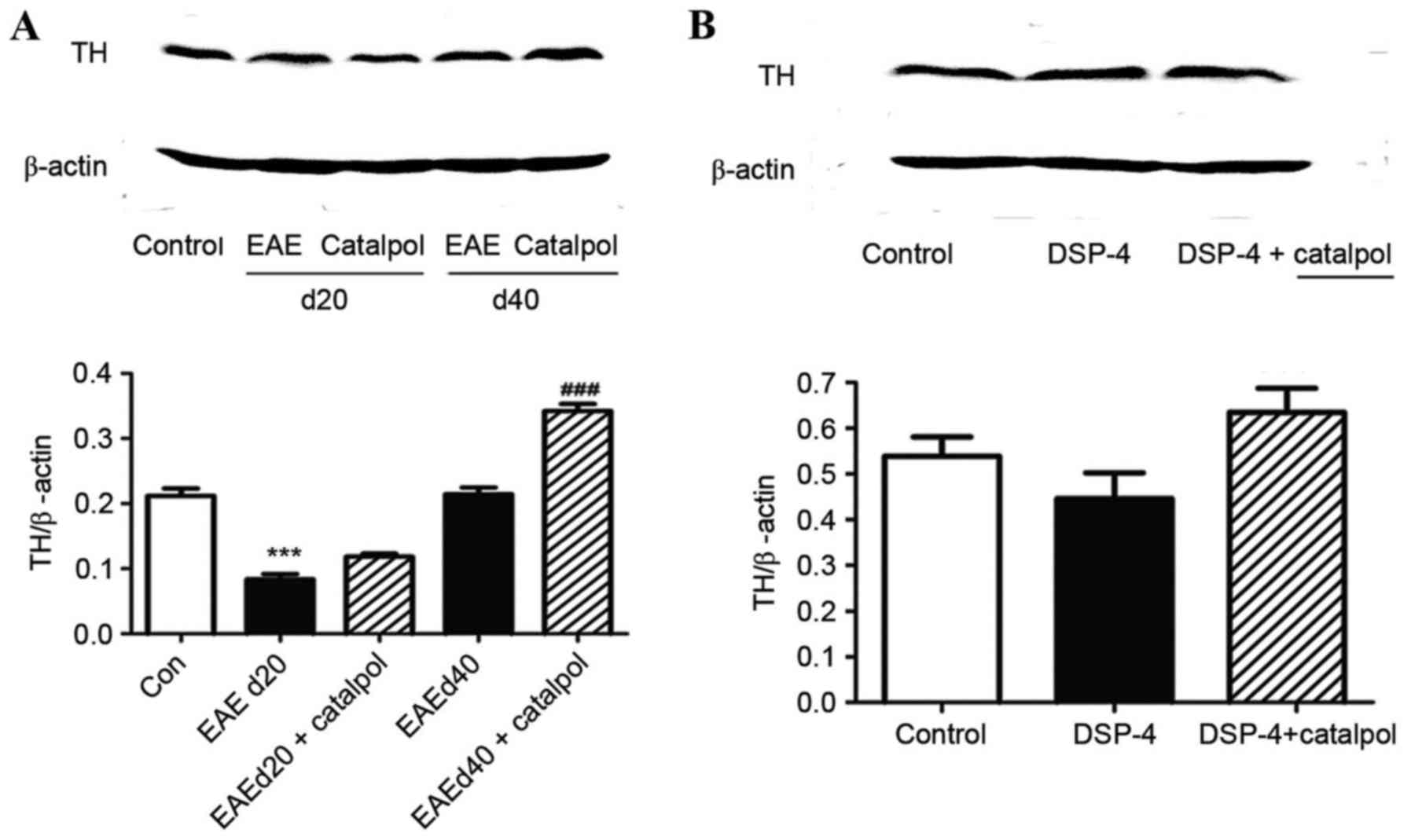 |
|
McQualter JL and Bernard CC: Multiple sclerosis: A battle between destruction and repair. J Neurochem. 100:295–306. 2007. View Article : Google Scholar : PubMed/NCBI | |
|
Deckx N, Lee WP, Berneman ZN and Cools N: Neuroendocrine immunoregulation in multiple sclerosis. Clin Dev Immunol. 2013:7052322013. View Article : Google Scholar : PubMed/NCBI | |
|
Alvarez JI, Cayrol R and Prat A: Disruption of central nervous system barriers in multiple sclerosis. Biochim Biophys Acta. 1812:252–264. 2011. View Article : Google Scholar : PubMed/NCBI | |
|
Gadea M, Martinez-Bisbal MC, Marti-Bonmati L, Espert R, Casanova B, Coret F and Celda B: Spectroscopic axonal damage of the right locus coeruleus relates to selective attention impairment in early stage relapsing-remitting multiple sclerosis. Brain. 127:89–98. 2004. View Article : Google Scholar : PubMed/NCBI | |
|
Polak PE, Kalinin S and Feinstein DL: Locus coeruleus damage and noradrenaline reductions in multiple sclerosis and experimental autoimmune encephalomyelitis. Brain. 134:665–677. 2011. View Article : Google Scholar : PubMed/NCBI | |
|
Fritschy JM and Grzanna R: Experimentally-induced neuron loss in the locus coeruleus of adult rats. Exp Neurol. 111:123–127. 1991. View Article : Google Scholar : PubMed/NCBI | |
|
Simonini MV, Polak PE, Sharp A, McGuire S, Galea E and Feinstein DL: Increasing CNS noradrenaline reduces EAE severity. J Neuroimmune Pharmacol. 5:252–259. 2010. View Article : Google Scholar : PubMed/NCBI | |
|
White SR, Bhatnagar RK and Bardo MT: Norepinephrine depletion in the spinal cord gray matter of rats with experimental allergic encephalomyelitis. J Neurochem. 40:1771–1773. 1983. View Article : Google Scholar : PubMed/NCBI | |
|
Krenger W, Honegger CG, Feurer C and Cammisuli S: Changes of neurotransmitter systems in chronic relapsing experimental allergic encephalomyelitis in rat brain and spinal cord. J Neurochem. 47:1247–1254. 1986. View Article : Google Scholar : PubMed/NCBI | |
|
Marien MR, Colpaert FC and Rosenquist AC: Noradrenergic mechanisms in neurodegenerative diseases: A theory. Brain Res Brain Res Rev. 45:38–78. 2004. View Article : Google Scholar : PubMed/NCBI | |
|
Madrigal JL, Kalinin S, Richardson JC and Feinstein DL: Neuroprotective actions of noradrenaline: Effects on glutathione synthesis and activation of peroxisome proliferator activated receptor delta. J Neurochem. 103:2092–2101. 2007. View Article : Google Scholar : PubMed/NCBI | |
|
Frohman EM, Vayuvegula B, Gupta S and van den Noort S: Norepinephrine inhibits gamma-interferon-induced major histocompatibility class II (Ia) antigen expression on cultured astrocytes via beta-2-adrenergic signal transduction mechanisms. Proc Natl Acad Sci USA. 85:pp. 1292–1296. 1988; View Article : Google Scholar : PubMed/NCBI | |
|
Benveniste EN, Huneycutt BS, Shrikant P and Ballestas ME: Second messenger systems in the regulation of cytokines and adhesion molecules in the central nervous system. Brain Behav Immun. 9:304–314. 1995. View Article : Google Scholar : PubMed/NCBI | |
|
Feinstein DL: Suppression of astroglial nitric oxide synthase expression by norepinephrine results from decreased NOS-2 promoter activity. J Neurochem. 70:1484–1496. 1998. View Article : Google Scholar : PubMed/NCBI | |
|
Nakamura A, Johns EJ, Imaizumi A, Abe T and Kohsaka T: Regulation of tumour necrosis factor and interleukin-6 gene transcription by beta2-adrenoceptor in the rat astrocytes. J Neuroimmunol. 88:144–153. 1998. View Article : Google Scholar : PubMed/NCBI | |
|
Galea E, Heneka MT, Dello RC and Feinstein DL: Intrinsic regulation of brain inflammatory responses. Cell Mol Neurobiol. 23:625–635. 2003. View Article : Google Scholar : PubMed/NCBI | |
|
Fujita H, Tanaka J, Maeda N and Sakanaka M: Adrenergic agonists suppress the proliferation of microglia through beta 2-adrenergic receptor. Neurosci Lett. 242:37–40. 1998. View Article : Google Scholar : PubMed/NCBI | |
|
Heneka MT, Nadrigny F, Regen T, Martinez-Hernandez A, Dumitrescu-Ozimek L, Terwel D, Jardanhazi-Kurutz D, Walter J, Kirchhoff F, Hanisch UK and Kummer MP: Locus ceruleus controls Alzheimer's disease pathology by modulating microglial functions through norepinephrine. Proc Natl Acad Sci USA. 107:pp. 6058–6063. 2010; View Article : Google Scholar : PubMed/NCBI | |
|
Kong Y, Ruan L, Qian L, Liu X and Le Y: Norepinephrine promotes microglia to uptake and degrade amyloid beta peptide through upregulation of mouse formyl peptide receptor 2 and induction of insulin-degrading enzyme. J Neurosci. 30:11848–11857. 2010. View Article : Google Scholar : PubMed/NCBI | |
|
Campbell A: Inflammation, neurodegenerative diseases, and environmental exposures. Ann N Y Acad Sci. 1035:117–132. 2004. View Article : Google Scholar : PubMed/NCBI | |
|
Zafra F, Lindholm D, Castrén E, Hartikka J and Thoenen H: Regulation of brain-derived neurotrophic factor and nerve growth factor mRNA in primary cultures of hippocampal neurons and astrocytes. J Neurosci. 12:4793–4799. 1992.PubMed/NCBI | |
|
Remy S, Naveilhan P, Brachet P and Neveu I: Differential regulation of GDNF, neurturin, and their receptors in primary cultures of rat glial cells. J Neurosci Res. 64:242–251. 2001. View Article : Google Scholar : PubMed/NCBI | |
|
Kajitani N, Hisaoka-Nakashima K, Morioka N, Okada-Tsuchioka M, Kaneko M, Kasai M, Shibasaki C, Nakata Y and Takebayashi M: Antidepressant acts on astrocytes leading to an increase in the expression of neurotrophic/growth factors: Differential regulation of FGF-2 by noradrenaline. PLoS One. 7:e511972012. View Article : Google Scholar : PubMed/NCBI | |
|
Ghiani CA, Eisen AM, Yuan X, DePinho RA, McBain CJ and Gallo V: Neurotransmitter receptor activation triggers p27 (Kip1) and p21 (CIP1) accumulation and G1 cell cycle arrest in oligodendrocyte progenitors. Development. 126:1077–1090. 1999.PubMed/NCBI | |
|
Kaneko YS, Mori K, Nakashima A, Sawada M, Nagatsu I and Ota A: Peripheral injection of lipopolysaccharide enhances expression of inflammatory cytokines in murine locus coeruleus: Possible role of increased norepinephrine turnover. J Neurochem. 94:393–404. 2005. View Article : Google Scholar : PubMed/NCBI | |
|
Kalinin S, Polak PE, Madrigal JL, Gavrilyuk V, Sharp A, Chauhan N, Marien M, Colpaert F and Feinstein DL: Beta-amyloid-dependent expression of NOS2 in neurons: Prevention by an alpha2-adrenergic antagonist. Antioxid Redox Signal. 8:873–883. 2006. View Article : Google Scholar : PubMed/NCBI | |
|
O'Sullivan JB, Ryan KM, Curtin NM, Harkin A and Connor TJ: Noradrenaline reuptake inhibitors limit neuroinflammation in rat cortex following a systemic inflammatory challenge: Implications for depression and neurodegeneration. Int J Neuropsychopharmacol. 12:687–699. 2009. View Article : Google Scholar : PubMed/NCBI | |
|
O'Sullivan JB, Ryan KM, Harkin A and Connor TJ: Noradrenaline reuptake inhibitors inhibit expression of chemokines IP-10 and RANTES and cell adhesion molecules VCAM-1 and ICAM-1 in the CNS following a systemic inflammatory challenge. J Neuroimmunol. 220:34–42. 2010. View Article : Google Scholar : PubMed/NCBI | |
|
Benarroch EE: The locus ceruleus norepinephrine system: Functional organization and potential clinical significance. Neurology. 73:1699–1704. 2009. View Article : Google Scholar : PubMed/NCBI | |
|
Szabadi E: Functional neuroanatomy of the central noradrenergic system. J Psychopharmacol. 27:659–693. 2013. View Article : Google Scholar : PubMed/NCBI | |
|
Iversen LL, Rossor MN, Reynolds GP, Hills R, Roth M, Mountjoy CQ, Foote SL, Morrison JH and Bloom FE: Loss of pigmented dopamine-beta-hydroxylase positive cells from locus coeruleus in senile dementia of Alzheimer's type. Neurosci Lett. 39:95–100. 1983. View Article : Google Scholar : PubMed/NCBI | |
|
Berridge CW and Waterhouse BD: The locus coeruleus-noradrenergic system: Modulation of behavioral state and state-dependent cognitive processes. Brain Res Brain Res Rev. 42:33–84. 2003. View Article : Google Scholar : PubMed/NCBI | |
|
Li DQ, Bao YM, Li Y, Wang CF, Liu Y and An LJ: Catalpol modulates the expressions of Bcl-2 and Bax and attenuates apoptosis in gerbils after ischemic injury. Brain Res. 1115:179–185. 2006. View Article : Google Scholar : PubMed/NCBI | |
|
Tian YY, Jiang B, An LJ and Bao YM: Neuroprotective effect of catalpol against MPP(+)-induced oxidative stress in mesencephalic neurons. Eur J Pharmacol. 568:142–148. 2007. View Article : Google Scholar : PubMed/NCBI | |
|
Jiang B, Du J, Liu JH, Bao YM and An LJ: Catalpol attenuates the neurotoxicity induced by beta-amyloid (1–42) in cortical neuron-glia cultures. Brain Res. 1188:139–147. 2008. View Article : Google Scholar : PubMed/NCBI | |
|
Liang JH, Du J, Xu LD, Jiang T, Hao S, Bi J and Jiang B: Catalpol protects primary cultured cortical neurons induced by Abeta(1–42) through a mitochondrial-dependent caspase pathway. Neurochem Int. 55:741–746. 2009. View Article : Google Scholar : PubMed/NCBI | |
|
Liu J, He QJ, Zou W, Wang HX, Bao YM, Liu YX and An LJ: Catalpol increases hippocampal neuroplasticity and up-regulates PKC and BDNF in the aged rats. Brain Res. 1123:68–79. 2006. View Article : Google Scholar : PubMed/NCBI | |
|
Zhang XL, An LJ, Bao YM, Wang JY and Jiang B: d-galactose administration induces memory loss and energy metabolism disturbance in mice: Protective effects of catalpol. Food Chem Toxicol. 46:2888–2894. 2008. View Article : Google Scholar : PubMed/NCBI | |
|
Xia Z, Zhang R, Wu P, Xia Z and Hu Y: Memory defect induced by β-amyloid plus glutamate receptor agonist is alleviated by catalpol and donepezil through different mechanisms. Brain Res. 1441:27–37. 2012. View Article : Google Scholar : PubMed/NCBI | |
|
Feinstein DL, Galea E, Gavrilyuk V, Brosnan CF, Whitacre CC, Dumitrescu-Ozimek L, Landreth GE, Pershadsingh HA, Weinberg G and Heneka MT: Peroxisome proliferator-activated receptor-gamma agonists prevent experimental autoimmune encephalomyelitis. Ann Neurol. 51:694–702. 2002. View Article : Google Scholar : PubMed/NCBI | |
|
Heneka MT, Galea E, Gavriluyk V, Dumitrescu-Ozimek L, Daeschner J, O'Banion MK, Weinberg G, Klockgether T and Feinstein DL: Noradrenergic depletion potentiates beta-amyloid-induced cortical inflammation: Implications for Alzheimer's disease. J Neurosci. 22:2434–2442. 2002.PubMed/NCBI | |
|
Giuliani F, Metz LM, Wilson T, Fan Y, Bar-Or A and Yong VW: Additive effect of the combination of glatiramer acetate and minocycline in a model of MS. J Neuroimmunol. 158:213–221. 2005. View Article : Google Scholar : PubMed/NCBI | |
|
Weaver A, Goncalves da Silva A, Nuttall RK, Edwards DR, Shapiro SD, Rivest S and Yong VW: An elevated matrix metalloproteinase (MMP) in an animal model of multiple sclerosis is protective by affecting Th1/Th2 polarization. FASEB J. 19:1668–1670. 2005. View Article : Google Scholar : PubMed/NCBI | |
|
Jiang B, Zhang H, Bi J and Zhang XL: Neuroprotective activities of catalpol on MPP+/MPTP-induced neurotoxicity. Neurol Res. 30:639–644. 2008. View Article : Google Scholar : PubMed/NCBI | |
|
Holm PC, Rodriguez FJ, Kresse A, Canals JM, Silos-Santiago I and Arenas E: Crucial role of TrkB ligands in the survival and phenotypic differentiation of developing locus coeruleus noradrenergic neurons. Development. 130:3535–3545. 2003. View Article : Google Scholar : PubMed/NCBI | |
|
Flueraru M, So R, Willmore WG, Poulter MO, Durst T, Charron M and Wright JS: Cytotoxicity and cytoprotective activity of naphthalenediols in rat cortical neurons. Chem Res Toxicol. 19:1221–1217. 2006. View Article : Google Scholar : PubMed/NCBI | |
|
Jonsson G, Hallman H, Ponzio F and Ross S: DSP4 (N-(2-chloroethyl)-N-ethyl-2-bromobenzylamine)-a useful denervation tool for central and peripheral noradrenaline neurons. Eur J Pharmacol. 72:173–188. 1981. View Article : Google Scholar : PubMed/NCBI | |
|
Hallman H and Jonsson G: Pharmacological modifications of the neurotoxic action of the noradrenaline neurotoxin DSP4 on central noradrenaline neurons. Eur J Pharmacol. 103:269–278. 1984. View Article : Google Scholar : PubMed/NCBI | |
|
Landa ME, Rubio MC and Jaim-Etcheverry G: The neurotoxic compound N-(2-chloroethyl)-N-ethyl-2-bromobenzylamine hydrochloride (DSP4) depletes endogenous norepinephrine and enhances release of [3H]norepinephrine from rat cortical slices. J Pharmacol Exp Ther. 231:131–136. 1984.PubMed/NCBI | |
|
Cassano T, Gaetani S, Morgese MG, Macheda T, Laconca L, Dipasquale P, Taltavull J, Shippenberg TS, Cuomo V and Gobbi G: Monoaminergic changes in locus coeruleus and dorsal raphe nucleus following noradrenaline depletion. Neurochem Res. 34:1417–1426. 2009. View Article : Google Scholar : PubMed/NCBI | |
|
Dowdell KC, Gienapp IE, Stuckman S, Wardrop RM and Whitacre CC: Neuroendocrine modulation of chronic relapsing experimental autoimmune encephalomyelitis: A critical role for the hypothalamic-pituitary-adrenal axis. J Neuroimmunol. 100:243–251. 1999. View Article : Google Scholar : PubMed/NCBI | |
|
Cosentino M, Zaffaroni M, Marino F, Bombelli R, Ferrari M, Rasini E, Lecchini S, Ghezzi A and Frigo G: Catecholamine production and tyrosine hydroxylase expression in peripheral blood mononuclear cells from multiple sclerosis patients: Effect of cell stimulation and possible relevance for activation-induced apoptosis. J Neuroimmunol. 133:233–240. 2002. View Article : Google Scholar : PubMed/NCBI | |
|
Rajda C, Bencsik K, Vécsei LL and Bergquist J: Catecholamine levels in peripheral blood lymphocytes from multiple sclerosis patients. J Neuroimmunol. 124:93–100. 2002. View Article : Google Scholar : PubMed/NCBI | |
|
Helkamaa T, Reenilä I, Tuominen RK, Soinila S, Väänänen A, Tilgmann C and Rauhala P: Increased catechol-O-methyltransferase activity and protein expression in OX-42-positive cells in the substantia nigra after lipopolysaccharide microinfusion. Neurochem Int. 51:412–423. 2007. View Article : Google Scholar : PubMed/NCBI | |
|
Samantaray S, Knaryan VH, Butler JT, Ray SK and Banik NL: Spinal cord degeneration in C57BL/6N mice following induction of experimental parkinsonism with MPTP. J Neurochem. 104:1309–1320. 2008. View Article : Google Scholar : PubMed/NCBI | |
|
Martel J, Chopin P, Colpaert F and Marien M: Neuroprotective effects of the alpha2-adrenoceptor antagonists, (+)-efaroxan and (+/-)-idazoxan, against quinolinic acid-induced lesions of the rat striatum. Exp Neurol. 154:595–601. 1998. View Article : Google Scholar : PubMed/NCBI | |
|
Veyrac A, Didier A, Colpaert F, Jourdan F and Marien M: Activation of noradrenergic transmission by alpha2-adrenoceptor antagonists counteracts deafferentation-induced neuronal death and cell proliferation in the adult mouse olfactory bulb. Exp Neurol. 194:444–456. 2005. View Article : Google Scholar : PubMed/NCBI | |
|
Hashioka S, Klegeris A, Monji A, Kato T, Sawada M, McGeer PL and Kanba S: Antidepressants inhibit interferon-gamma-induced microglial production of IL-6 and nitric oxide. Exp Neurol. 206:33–42. 2007. View Article : Google Scholar : PubMed/NCBI | |
|
Russo-Neustadt A, Beard RC and Cotman CW: Exercise, antidepressant medications, and enhanced brain derived neurotrophic factor expression. Neuropsychopharmacology. 21:679–682. 1999. View Article : Google Scholar : PubMed/NCBI | |
|
Goldstein DS: L-Dihydroxyphenylserine (L-DOPS): A norepinephrine prodrug. Cardiovasc Drug Rev. 24:189–203. 2006. View Article : Google Scholar : PubMed/NCBI | |
|
Puri BK, Bydder GM, Chaudhuri KR, Al Saffar BY, Curati WL, White SJ, Mitchell L, Hajnal JV and Horrobin DF: MRI changes in multiple sclerosis following treatment with lofepramine and L-phenylalanine. Neuroreport. 12:1821–1824. 2001. View Article : Google Scholar : PubMed/NCBI | |
|
Loder C, Allawi J and Horrobin DF: Treatment of multiple sclerosis with lofepramine, L-phenylalanine and vitamin B (12): Mechanism of action and clinical importance: Roles of the locus coeruleus and central noradrenergic systems. Med Hypotheses. 59:594–602. 2002. View Article : Google Scholar : PubMed/NCBI | |
|
Stjarne L, Lishajko F and Roth RH: Regulation of noradrenaline biosynthesis in nerve tissue. Nature. 215:770–772. 1967. View Article : Google Scholar : PubMed/NCBI | |
|
Bardou I, Kaercher RM, Brothers HM, Hopp SC, Royer S and Wenk GL: Age and duration of inflammatory environment differentially affect the neuroimmune response and catecholaminergic neurons in the midbrain and brainstem. Neurobiol Aging. 35:1065–1073. 2014. View Article : Google Scholar : PubMed/NCBI | |
|
Grudzien A, Shaw P, Weintraub S, Bigio E, Mash DC and Mesulam MM: Locus coeruleus neurofibrillary degeneration in aging, mild cognitive impairment and early Alzheimer's disease. Neurobiol Aging. 28:327–335. 2007. View Article : Google Scholar : PubMed/NCBI | |
|
Polak PE, Kalinin S, Braun D, Sharp A, Lin SX and Feinstein DL: The vincamine derivative vindeburnol provides benefit in a mouse model of multiple sclerosis: Effects on the Locus coeruleus. J Neurochem. 121:206–216. 2012. View Article : Google Scholar : PubMed/NCBI | |
|
Weissmann D, Labatut R, Gillon J, Richard F and Pujol J: Measurement of brain tyrosine hydroxylase concentrations by quantitative autoradiography after transfer of soluble proteins to nitro-cellulose. C R Acad Sci III. 306:457–460. 1988.(In French). PubMed/NCBI | |
|
He Y, Zhu H, Li W, Chen G, Li Z and Xu X: HPLC determination of catalpol in cerebrospinal fluid of rats. Zhong Guo Zhong Yao Za Zhi. 34:1717–1719. 2009.(In Chinese). | |
|
Wan D, Zhu HF, Luo Y, Xie P and Xu XY: Study of catalpol promoting axonal growth for cultured cortical neurons from rats. Zhongguo Zhong Yao Za Zhi. 32:1771–1774. 2007.(In Chinese). PubMed/NCBI | |
|
Tian YY, An LJ, Jiang L, Duan YL, Chen J and Jiang B: Catalpol protects dopaminergic neurons from LPS-induced neurotoxicity in mesencephalic neuron-glia cultures. Life Sci. 80:193–199. 2006. View Article : Google Scholar : PubMed/NCBI |









